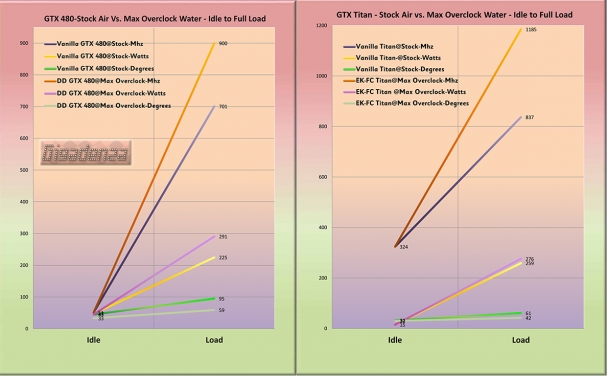H20+TDP=Pointless or Productive…?
Degrees Vs. Watts Vs. Mhz
A brief harvest of HTML tells us the GTX Titan’s premium water cooling accoutrements can maintain load temperatures as low as 42 degrees. Though we cannot assume this tempting figure would match that of our subject, whose tests were conducted under different conditions, it nevertheless sounds impressive. The question is, what return in megahertz would such a drop translate to and how long before wattage rose sufficiently to once again make temperature an irrelevance?
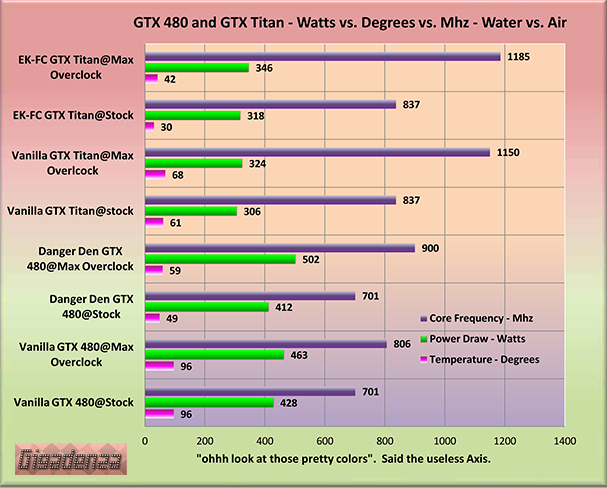
These figures are “mean averages” based on statistics collated from various reviews and show the performance gains possible for the Titan and the 480 when each is armed with lordly liquid laden defences.
The Danger Den water block used on the 480 is a commendably customised nickel plated creation, skilfully crafted by the Oregon based company to envelop the most thermally volatile components, including the memory and voltage regulators, besides the feverish Fermi. The block itself is engineered in a single part with a mesmerically mirrored finish and lusciously lapped base. Raised ridges on the underside guarantee optimal contact with the RAM.
After removing the original cooling assembly, and the routine “clean and paste”…
Hmm. How much? A grain of rice, half a pea, a sprout, a plum, a lime? Should I spread or should I squish?
….it is attached to the card via four screws and rubber wasters. The Vregs populating the card’s top-front are left exposed, unlike those on EVGA’s copper bottomed Fermi Eulogy (The Hydro FTW Edition) which uses proprietary aquatics co-developed by themselves and Swiftech. In the interests of assessing the most beneficial solutions, it would have been ideal to include this model in our investigation, I searched like a Mythbuster and sadly, the internet imparted insufficient data.
Turning our attention to the Titan’s honoured hydrator, the EK-FC is developed, manufactured and distributed by EKWB, a small, highly specialised firm based in Slovenia. When compared to the Danger Den, save for a squarer stature and a peppering of perspex, the pair are a submersible sister act. The dual part design consists of a sturdy retention plate mounted on the card’s rear, and an electrolytic copper block, also nickel plated, covering the RAM, GPU and healthy majority of VRMs. It’s optional backplate may foil the Kepler’s feverish fear of farenheit by a dwindling degree, but not enough to eschew any crucial calculations.
In the chart we have two groups of results with four tests for each and three variables per test. The axis labels on left identify our subjects and the tests conducted.
Power draw, temperature, and core frequencies for the ready salted, air-cooled cards in their stock and super charged states and the same set of values for our submerged participants when tweaked to their respective extremes. Results for the water cooled cards in their default state are also included for reference.
Divulging a detailed analysis would be as pointless as a broken pencil in the hands of a humble hobbyist who has compiled a delicious quad layer charter pounder to an avoid any arduous analysis. Thus, I shall let these bounty-ful bars flower fruitful facts unassisted. Just be mindful that all thermal and power measurements were taken when both GPUs were sailing at full steam and we are not concerned about their comparative speeds, but the extent to which each flourished below its flow of fancy fluid.
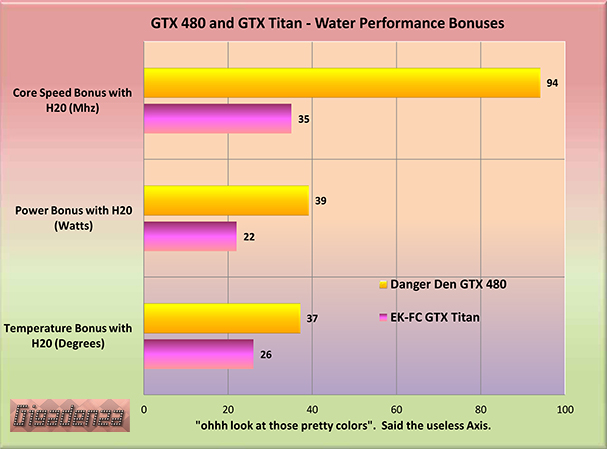
In charming canary yellow and candy pink may I present the the increases in real terms, calculated as follows:
Temperature Reduction – Subtracting the results of each amphibious card from those under air’s care.
Power Bonus – Reversing the above equation.
Core and Memory Frequency Gains – Same way as power.
As predicted, it is the infernal Fermi that better quenches its thirst, delivering a sharper cut in thermals and markedly higher energy and performance returns. How will these figures translate to percentages. Oh! The excitement, let’s find out!
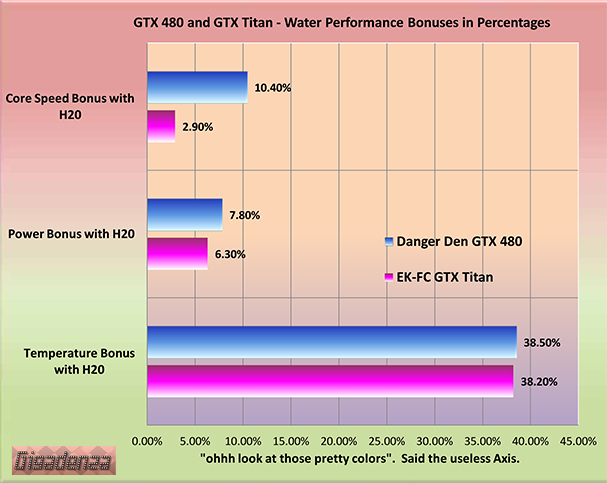
Hmm, a Colour a scheme unworthy of a washed up feng shui consultant. Never mind, its the figures we seek. These percentage gains are generally commensurate with their numerical counterparts, though The Titan’s heat shedding appears more impressive when interpreted as a percentage due to the Fermi’s notoriously high native temperatures.
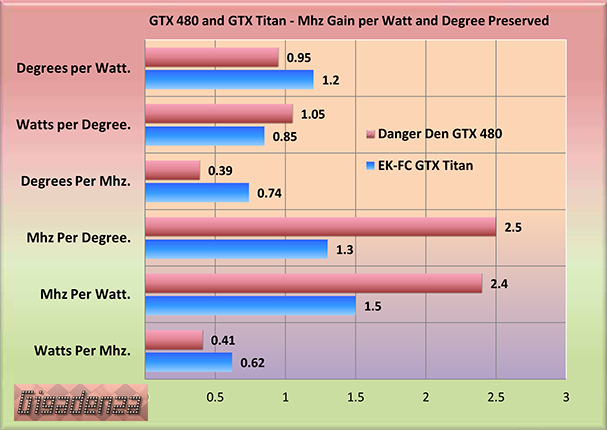
In a tactfully tasteful pastel red reminiscent of Shepard’s delight at night, a flaming barn at dawn and enough placatory blue to extinguish it, here is the final slice of crunchy chart tart. The figures adequately account for themselves and their formulae amounts to nothing but divide and divide and divide and….conquer.
Watts per mhz = power bonus/core frequency gain. Mhz per watt = reverse the above etc etc etc.
Did We Get Anywhere?
Sadly there is no magic equation, no Newton’s law or Einstein’s theory because every card and indeed any energy consuming device has exclusive requirements and infinitely contrasting levels of efficiency. Nevertheless, the power and temperature curves of our Danger Den adorned 480 come very close to those of Tech Powerup’s Zotac, 1.05 watts per degree for the former and 1.2 for the latter.
Moreover, our marginally lower value makes sense since it was obtained from an average calculation based on considerably wider thermal and power ranges. Had actual measurements been taken, the both traces would escalate in uneven increments and either steepen or level off toward the end. Nevertheless, this at least lends some credence to our presumptuous calculations.
In conclusion, our theory from many a graph ago is substantiated. It is far more difficult to apply the virtues of elaborate water cooling to indigenously frugal frame savants like the Titan, than parched pixel savages such as the GTX 480, let alone avail its value for hard cash. Or is it?
The pair of charts above display the thermal, power and frequency spectrum of both air assisted cards at their default speeds and compares them with the same values garnered from our coolant craving counterparts when clocked to submission.
Anybody glancing would glean the exact opposite of what this exhaustive experiment set out to establish, though I publish them for posterity with good reasons.
First, to cut short those cacophonous cries of bias, second to warn that when it comes to statistical integrity, even the most impartial collection of facts and figures is futile in face of sly selectivity and strenuously slick spin.
I admit, there is a third reason . They took me bloody ages and I had to justify their inclusion with a florid philosophical discharge.
This is Where the Story Really Ends
In the case of the contemporary video card, that is, as things stood, now stand and shall continue standing for as long as is necessary to preserve the relevance of our latest departure from simplicity, what we can conclude is, the greener the design – in more senses than the obvious – the lower its designer will decree the TDP and for long as this limit retains its powers of self-preservation, the joys hydro therapy will remain partial and disproportionally extravagant. Bah! exclaim the experts, just take a screwdriver and lobotomise that card’s loathsome autonomy. Perhaps it would be safer to wait for GPU Boost 3.0.





